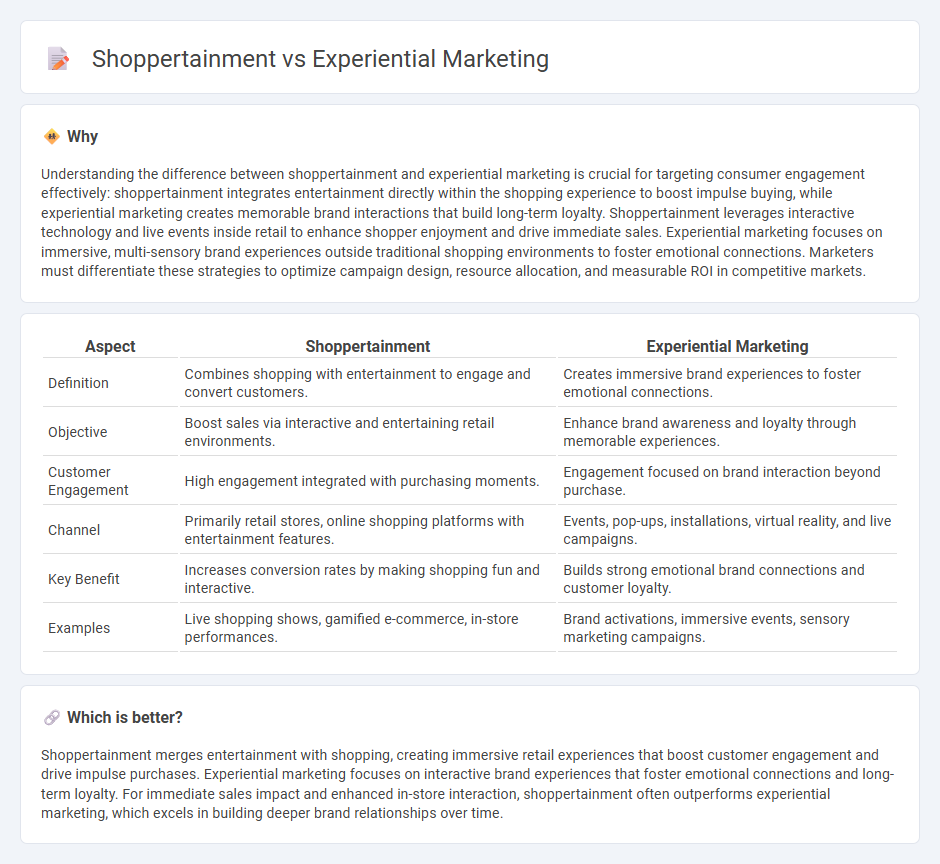
Shoppertainment combines immersive entertainment elements with shopping to enhance customer engagement and boost sales, leveraging interactive technologies and live events. Experiential marketing focuses on creating memorable brand experiences through direct consumer interactions, emphasizing emotional connection and brand loyalty. Discover how these dynamic marketing strategies can transform consumer behavior and drive business growth.
Why it is important
Understanding the difference between shoppertainment and experiential marketing is crucial for targeting consumer engagement effectively: shoppertainment integrates entertainment directly within the shopping experience to boost impulse buying, while experiential marketing creates memorable brand interactions that build long-term loyalty. Shoppertainment leverages interactive technology and live events inside retail to enhance shopper enjoyment and drive immediate sales. Experiential marketing focuses on immersive, multi-sensory brand experiences outside traditional shopping environments to foster emotional connections. Marketers must differentiate these strategies to optimize campaign design, resource allocation, and measurable ROI in competitive markets.
Comparison Table
| Aspect | Shoppertainment | Experiential Marketing |
|---|---|---|
| Definition | Combines shopping with entertainment to engage and convert customers. | Creates immersive brand experiences to foster emotional connections. |
| Objective | Boost sales via interactive and entertaining retail environments. | Enhance brand awareness and loyalty through memorable experiences. |
| Customer Engagement | High engagement integrated with purchasing moments. | Engagement focused on brand interaction beyond purchase. |
| Channel | Primarily retail stores, online shopping platforms with entertainment features. | Events, pop-ups, installations, virtual reality, and live campaigns. |
| Key Benefit | Increases conversion rates by making shopping fun and interactive. | Builds strong emotional brand connections and customer loyalty. |
| Examples | Live shopping shows, gamified e-commerce, in-store performances. | Brand activations, immersive events, sensory marketing campaigns. |
Which is better?
Shoppertainment merges entertainment with shopping, creating immersive retail experiences that boost customer engagement and drive impulse purchases. Experiential marketing focuses on interactive brand experiences that foster emotional connections and long-term loyalty. For immediate sales impact and enhanced in-store interaction, shoppertainment often outperforms experiential marketing, which excels in building deeper brand relationships over time.
Connection
Shoppertainment combines entertainment elements with shopping experiences to engage consumers emotionally, enhancing brand interaction and purchase intent. Experiential marketing focuses on creating immersive, memorable events or environments that allow consumers to interact directly with products or services. Both strategies leverage sensory engagement and emotional connection to elevate consumer involvement, driving higher conversion rates and brand loyalty.
Key Terms
**Experiential Marketing:**
Experiential marketing creates immersive brand experiences that engage consumers through sensory stimuli and emotional connections, enhancing brand recall and loyalty. It leverages interactive events, virtual reality, and personalized activations to foster meaningful consumer interactions that traditional advertising cannot achieve. Discover more about how experiential marketing transforms customer engagement and drives business growth.
Brand Immersion
Experiential marketing creates immersive brand interactions that engage consumers through live events and sensory experiences, fostering emotional connections and long-term loyalty. Shoppertainment integrates entertainment elements within retail spaces, combining shopping and fun to enhance customer engagement and increase purchase intent. Discover how blending these strategies elevates brand immersion and transforms consumer experiences.
Sensory Engagement
Experiential marketing leverages immersive, multi-sensory brand interactions that engage customers' emotions and behaviors to create lasting impressions. Shoppertainment blends entertainment with shopping, using sensory stimuli such as sights, sounds, and interactive elements to enhance the retail experience and drive consumer engagement. Discover how these dynamic strategies transform consumer behavior and elevate brand loyalty.
Source and External Links
Experiential Marketing: How To Create Immersive Brand Experiences - Experiential marketing engages consumers through memorable, immersive brand experiences like pop-ups and live events to build emotional connections, differing from traditional marketing by focusing on engagement and long-term loyalty over direct KPIs.
What is experiential marketing? Definition and examples - Experiential marketing connects brands with consumers through interactive experiences, often combining in-person and digital elements, aiming to create memorable moments that are measurable by engagement and feedback.
What is experiential marketing: Definition, why it works & examples - Experiential marketing fosters authentic emotional engagement, enhances brand perception, and improves ROI by creating memorable sensory interactions that encourage word-of-mouth and social sharing among consumers.
 dowidth.com
dowidth.com